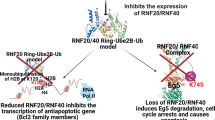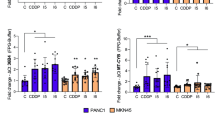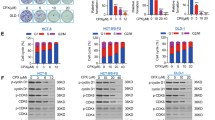Abstract
Systemic toxicity and tumor cell resistance still limit the efficacy of chemotherapy in colorectal cancer. Therefore, alternative treatments are desperately needed. The thiazolide Nitazoxanide (NTZ) is an FDA-approved drug for the treatment of parasite-mediated infectious diarrhea with a favorable safety profile. Interestingly, NTZ and the thiazolide RM4819—its bromo-derivative lacking antibiotic activity—are also promising candidates for cancer treatment. Yet the exact anticancer mechanism(s) of these compounds still remains unclear. In this study, we systematically investigated RM4819 and NTZ in 2D and 3D colorectal cancer culture systems. Both compounds strongly inhibited proliferation of colon carcinoma cell lines by promoting G1 phase cell cycle arrest. Thiazolide-induced cell cycle arrest was independent of the p53/p21 axis, but was mediated by inhibition of protein translation via the mTOR/c-Myc/p27 pathway, likely caused by inhibition of mitochondrial respiration. While both thiazolides demonstrated mitochondrial uncoupling activity, only RM4819 inhibited the mitochondrial respiratory chain complex III. Interestingly, thiazolides also potently inhibited the growth of murine colonic tumoroids in a comparable manner with cisplatin, while in contrast to cisplatin thiazolides did not affect the growth of primary intestinal organoids. Thus, thiazolides appear to have a tumor-selective antiproliferative activity, which offers new perspectives in the treatment of colorectal cancer.
This is a preview of subscription content, access via your institution
Access options
Subscribe to this journal
Receive 50 print issues and online access
$259.00 per year
only $5.18 per issue
Buy this article
- Purchase on Springer Link
- Instant access to full article PDF
Prices may be subject to local taxes which are calculated during checkout






Similar content being viewed by others
References
Longley DB, Harkin DP, Johnston PG. 5-fluorouracil: mechanisms of action and clinical strategies. Nat Rev Cancer. 2003;3:330–8.
Kuipers EJ, Grady WM, Lieberman D, Seufferlein T, Sung JJ, Boelens PG, et al. Colorectal cancer. Nat Rev Prim. 2015;1:15065.
Kozovska Z, Gabrisova V, Kucerova L. Colon cancer: cancer stem cells markers, drug resistance and treatment. Biomed Pharmacother. 2014;68:911–6.
Ciardiello D, Vitiello PP, Cardone C, Martini G, Troiani T, Martinelli E, et al. Immunotherapy of colorectal cancer: challenges for therapeutic efficacy. Cancer Treat Rev. 2019;76:22–32.
Pushpakom S, Iorio F, Eyers PA, Escott KJ, Hopper S, Wells A, et al. Drug repurposing: progress, challenges and recommendations. Nat Rev Drug Discov. 2018;41–58.
Fox LM, Saravolatz LD. Nitazoxanide: a new thiazolide antiparasitic agent. Clin Infect Dis. 2005;40:1173–80.
Yamamoto Y, Hakki A, Friedman H, Okubo S, Shimamura T, Hoffman PS, et al. Nitazoxanide, a nitrothiazolide antiparasitic drug, is an anti-Helicobacter pylori agent with anti-vacuolating toxin activity. Chemotherapy. 1999;45:303–12.
McVay CS, Rolfe RD. In vitro and in vivo activities of nitazoxanide against Clostridium difficile. Antimicrob Agents Chemother. 2000;44:2254–8.
Guttner Y, Windsor HM, Viiala CH, Dusci L, Marshall BJ. Nitazoxanide in treatment of Helicobacter pylori: a clinical and in vitro study. Antimicrob Agents Chemother. 2003;47:3780–3.
Aslam S, Musher DM. Nitazoxanide: clinical studies of a broad-spectrum anti-infective agent. Future Microbiol. 2007;2:583–90.
de Carvalho LPS, Lin G, Jiang X, Nathan C. Nitazoxanide kills replicating and nonreplicating Mycobacterium tuberculosis and evades resistance. J Med Chem. 2009;52:5789–92.
de Carvalho LPS, Darby CM, Rhee KY, Nathan C. Nitazoxanide Disrupts Membrane Potential and Intrabacterial pH Homeostasis of Mycobacterium tuberculosis. ACS Med Chem Lett. 2011;2:849–54.
Lam KKY, Zheng X, Forestieri R, Balgi AD, Nodwell M, Vollett S, et al. Nitazoxanide stimulates autophagy and inhibits mTORC1 signaling and intracellular proliferation of Mycobacterium tuberculosis. PLoS Pathog. 2012;8:e1002691.
Lateef M, Zargar SA, Khan AR, Nazir M, Shoukat A. Successful treatment of niclosamide- and praziquantel-resistant beef tapeworm infection with nitazoxanide. Int J Infect Dis. 2008;12:80–2.
Ashour DS, Abou Rayia DM, Saad AE, El-Bakary RH. Nitazoxanide anthelmintic activity against the enteral and parenteral phases of trichinellosis in experimentally infected rats. Exp Parasitol 2016;170:28–35.
Rossignol JF, Maisonneuve H. Nitazoxanide in the treatment of Taenia saginata and Hymenolepis nana infections. Am J Trop Med Hyg. 1984;33:511–2.
Juan JO, Lopez Chegne N, Gargala G, Favennec L. Comparative clinical studies of nitazoxanide, albendazole and praziquantel in the treatment of ascariasis, trichuriasis and hymenolepiasis in children from Peru. Trans R Soc Trop Med Hyg. 2002;96:193–6.
Favennec L, Jave Ortiz J, Gargala G, Lopez Chegne N, Ayoub A, Rossignol JF. Double-blind, randomized, placebo-controlled study of nitazoxanide in the treatment of fascioliasis in adults and children from northern Peru. Aliment Pharmacol Ther. 2003;17:265–70.
Rossignol J-F. Nitazoxanide: a first-in-class broad-spectrum antiviral agent. Antivir Res 2014;110:94–103.
Rossignol J-F. Nitazoxanide, a new drug candidate for the treatment of Middle East respiratory syndrome coronavirus. J Infect Public Health. 2016;9:227–30.
Perelygina L, Hautala T, Seppänen M, Adebayo A, Sullivan KE, Icenogle J. Inhibition of rubella virus replication by the broad-spectrum drug nitazoxanide in cell culture and in a patient with a primary immune deficiency. Antivir Res. 2017;147:58–66.
Tilmanis D, van Baalen C, Oh DY, Rossignol J-F, Hurt AC. The susceptibility of circulating human influenza viruses to tizoxanide, the active metabolite of nitazoxanide. Antivir Res. 2017;147:142–8.
Hickson SE, Margineantu D, Hockenbery DM, Simon JA, Geballe AP. Inhibition of vaccinia virus replication by nitazoxanide. Virology. 2018;518:398–405.
Piacentini S, La Frazia S, Riccio A, Pedersen JZ, Topai A, Nicolotti O, et al. Nitazoxanide inhibits paramyxovirus replication by targeting the Fusion protein folding: role of glycoprotein-specific thiol oxidoreductase ERp57. Sci Rep. 2018;8:10425.
Di Santo N, Ehrisman J. A functional perspective of nitazoxanide as a potential anticancer drug. Mutat Res Mol Mech Mutagen. 2014;768:16–21.
Shakya A, Bhat HR, Ghosh SK. Update on nitazoxanide: a multifunctional chemotherapeutic agent. Curr Drug Discov Technol. 2018;15:201–13.
Muller J, Sidler D, Nachbur U, Wastling J, Brunner T, Hemphill A. Thiazolides inhibit growth and induce glutathione-S-transferase Pi (GSTP1)-dependent cell death in human colon cancer cells. Int J Cancer. 2008;123:1797–806.
Wang X, Shen C, Liu Z, Peng F, Chen X, Yang G, et al. Nitazoxanide, an antiprotozoal drug, inhibits late-stage autophagy and promotes ING1-induced cell cycle arrest in glioblastoma. Cell Death Dis. 2018;9:1032.
Qu Y, Olsen JR, Yuan X, Cheng PF, Levesque MP, Brokstad KA, et al. Small molecule promotes β-catenin citrullination and inhibits Wnt signaling in cancer. Nat Chem Biol. 2017;14:94–101.
Senkowski W, Zhang X, Olofsson MH, Isacson R, Hoglund U, Gustafsson M, et al. Three-dimensional cell culture-based screening identifies the anthelmintic drug nitazoxanide as a candidate for treatment of colorectal cancer. Mol Cancer Ther. 2015;14:1504–16.
Fan-Minogue H, Bodapati S, Solow-Cordero D, Fan A, Paulmurugan R, Massoud TF, et al. A c-Myc activation sensor-based high-throughput drug screening identifies an antineoplastic effect of nitazoxanide. Mol Cancer Ther. 2013;12:1896–905.
Sidler D, Brockmann A, Mueller J, Nachbur U, Corazza N, Renzulli P, et al. Thiazolide-induced apoptosis in colorectal cancer cells is mediated via the Jun kinase–Bim axis and reveals glutathione-S-transferase P1 as Achilles’ heel. Oncogene. 2012;31:4095–106.
Brockmann A, Strittmatter T, May S, Stemmer K, Marx A, Brunner T. Structure–function relationship of thiazolide-induced apoptosis in colorectal tumor cells. ACS Chem Biol. 2014;9:1520–7.
La Frazia S, Piacentini S, Riccio A, Rossignol JF, Santoro MG. The second-generation thiazolide haloxanide is a potent inhibitor of avian influenza virus replication. Antivir Res. 2018;157:159–68.
Stachulski AV, Santoro MG, Piacentini S, Belardo G, Frazia SL, Pidathala C, et al. Second-generation nitazoxanide derivatives: thiazolides are effective inhibitors of the influenza A virus. Future Med Chem. 2018;10:851–62.
Stachulski AV, Swift K, Cooper M, Reynolds S, Norton D, Slonecker SD, et al. Synthesis and pre-clinical studies of new amino-acid ester thiazolide prodrugs. Eur J Med Chem. 2017;126:154–9.
Webster PC. Alarm grows over management of antibiotic resistance file. CMAJ. 2010;182:E141–2.
Zaman SB, Hussain MA, Nye R, Mehta V, Mamun KT, Hossain N. A review on antibiotic resistance: alarm bells are ringing. Cureus. 2017;9:e1403.
Angelucci F, Cechova K, Amlerova J, Hort J. Antibiotics, gut microbiota, and Alzheimer’s disease. J Neuroinflamm. 2019;16:108.
Hu Y, Wong FS, Wen L. Antibiotics, gut microbiota, environment in early life and type 1 diabetes. Pharmacol Res. 2017;119:219–26.
Pankuch GA, Appelbaum PC. Activities of tizoxanide and nitazoxanide compared to those of five other thiazolides and three other agents against anaerobic species. Antimicrob Agents Chemother. 2006;50:1112–7.
Hauck L, von Harsdorf R. E2F transcription factors and pRb pocket proteins in cell cycle progression. Methods Mol Biol. 2005;296:239–45.
El-Deiry WS. p21(WAF1) Mediates cell-cycle inhibition, relevant to cancer suppression and therapy. Cancer Res 2016;76:5189–91.
Liu Y, Bodmer WF. Analysis of P53 mutations and their expression in 56 colorectal cancer cell lines. Proc Natl Acad Sci USA. 2006;103:976–81.
Chu IM, Hengst L, Slingerland JM. The Cdk inhibitor p27 in human cancer: prognostic potential and relevance to anticancer therapy. Nat Rev Cancer. 2008;8:253–67.
Hydbring P, Castell A, Larsson LG. MYC modulation around the CDK2/p27/SKP2 axis. Genes. 2017;8:E174.
Castell A, Larsson L-G. Targeting MYC translation in colorectal cancer. Cancer Discov. 2015;5:701–3.
Tsou P, Zheng B, Hsu C-H, Sasaki AT, Cantley LC. A fluorescent reporter of AMPK activity and cellular energy stress. Cell Metab. 2011;13:476–86.
Delp J, Funke M, Rudolf F, Cediel A, Bennekou SH, van der Stel W, et al. Development of a neurotoxicity assay that is tuned to detect mitochondrial toxicants. Arch Toxicol. 2019;93:1585–608.
Zhu Y, Dean AE, Horikoshi N, Heer C, Spitz DR, Gius D. Emerging evidence for targeting mitochondrial metabolic dysfunction in cancer therapy. J Clin Investig. 2018;128:3682–91.
Yan B, Dong L, Neuzil J. Mitochondria: an intriguing target for killing tumour-initiating cells. Mitochondrion. 2016;26:86–93.
Weinberg SE, Chandel NS. Targeting mitochondria metabolism for cancer therapy. Nat Chem Biol. 2015;11:9–15.
Fontaine E. Metformin-induced mitochondrial complex I inhibition: facts, uncertainties, and consequences. Front Endocrinol. 2018;9:753.
Bode KJ, Mueller S, Schweinlin M, Metzger M, Brunner T. A fast and simple fluorometric method to detect cell death in 3D intestinal organoids. BioTechniques. 2019;67:23–8.
Neufert C, Becker C, Neurath MF. An inducible mouse model of colon carcinogenesis for the analysis of sporadic and inflammation-driven tumor progression. Nat Protoc. 2007;2:1998–2004.
Xue X, Shah YM. In vitro organoid culture of primary mouse colon tumors. J Vis Exp. 2013;17:e50210.
Grabinger T, Delgado E, Brunner T. Analysis of cell death induction in intestinal organoids in vitro. Methods Mol Biol. 2016;1419:83–93.
Delp J, Gutbier S, Cerff M, Zasada C, Niedenfuhr S, Zhao L, et al. Stage-specific metabolic features of differentiating neurons: implications for toxicant sensitivity. Toxicol Appl Pharmacol. 2018;354:64–80.
Acknowledgements
This study has been supported by a research grants from the DFG-funded Konstanz Research School-Chemical Biology (KoRS-CB, GSC 2018), the BMBF (e:ToP program, NeuriTox), and the Projects from the European Union’s Horizon 2020 research and innovation program EU-ToxRisk (grant agreement No 681002) and ENDpoiNTs (grant agreement No 825759). PR received a fellowship from the Deutscher Akademischer Austauschdienst (DAAD), JD and KB from the Baden-Württemberg Ministry of Science, Research and Art–funded Co-operative research training school InViTe. The authors like to thank A. Ahmed for technical help.
Author information
Authors and Affiliations
Corresponding author
Ethics declarations
Conflict of interest
The authors declare that they have no conflict of interest.
Additional information
Publisher’s note Springer Nature remains neutral with regard to jurisdictional claims in published maps and institutional affiliations.
Supplementary information
Rights and permissions
About this article
Cite this article
Ripani, P., Delp, J., Bode, K. et al. Thiazolides promote G1 cell cycle arrest in colorectal cancer cells by targeting the mitochondrial respiratory chain. Oncogene 39, 2345–2357 (2020). https://doi.org/10.1038/s41388-019-1142-6
Received:
Revised:
Accepted:
Published:
Issue Date:
DOI: https://doi.org/10.1038/s41388-019-1142-6
This article is cited by
-
Integrating spatial and single-cell transcriptomics reveals tumor heterogeneity and intercellular networks in colorectal cancer
Cell Death & Disease (2024)
-
Nitazoxanide inhibits acetylated KLF5-induced bone metastasis by modulating KLF5 function in prostate cancer
BMC Medicine (2023)
-
Emerging photodynamic/sonodynamic therapies for urological cancers: progress and challenges
Journal of Nanobiotechnology (2022)
-
The immuno-oncological challenge of COVID-19
Nature Cancer (2020)



